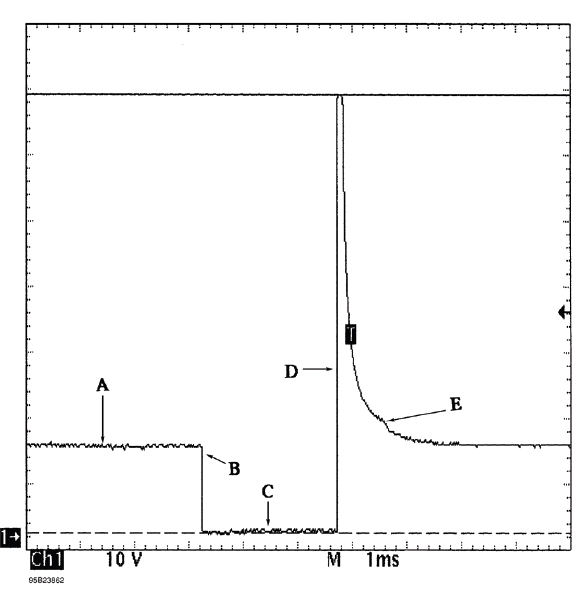Honda HR-V: Interpreting A Voltage Controlled Pattern
NOTE: Voltage controlled drivers are also known as "Saturated Switch" drivers. They typically require injector circuits with a total leg resistance of 12 ohms or more.
NOTE: This example is based on a constant power/switched ground circuit.
- See Fig. 2 for pattern that the following text describes.
Point "A" is where system voltage is supplied to the injector. A good hot run voltage is usually 13.5 or more volts. This point, commonly known as open circuit voltage, is critical because the injector will not get sufficient current saturation if there is a voltage shortfall. To obtain a good look at this precise point, you will need to shift your Lab Scope to five volts per division.
You will find that some systems have slight voltage fluctuations here. This can occur if the injector feed wire is also used to power up other cycling components, like the ignition coil(s). Slight voltage fluctuations are normal and are no reason for concern. Major voltage fluctuations are a different story, however. Major voltage shifts on the injector feed line will create injector performance problems. Look for excessive resistance problems in the feed circuit if you see big shifts and repair as necessary.
Note that circuits with external injector resistors will not be any different because the resistor does not affect open circuit voltage.
Point "B" is where the driver completes the circuit to ground. This point of the waveform should be a clean square point straight down with no rounded edges. It is during this period that current saturation of the injector windings is taking place and the driver is heavily stressed. Weak drivers will distort this vertical line.
Point "C" represents the voltage drop across the injector windings. Point "C" should come very close to the ground reference point, but not quite touch. This is because the driver has a small amount of inherent resistance.
Any significant offset from ground is an indication of a resistance problem on the ground circuit that needs repaired. You might miss this fault if you do not use the negative battery post for your Lab Scope hook-up, so it is HIGHLY recommended that you use the battery as your hook-up.
The points between "B" and "D" represent the time in milliseconds that the injector is being energized or held open. This line at Point "C" should remain flat. Any distortion or upward bend indicates a ground problem, short problem, or a weak driver. Alert readers will catch that this is exactly opposite of the current controlled type drivers (explained in the next section), because they bend upwards at this point.
How come the difference? Because of the total circuit resistance. Voltage controlled driver circuits have a high resistance of 12+ ohms that slows the building of the magnetic field in the injector. Hence, no counter voltage is built up and the line remains flat.
On the other hand, the current controlled driver circuit has low resistance which allows for a rapid magnetic field build-up. This causes a slight inductive rise (created by the effects of counter voltage) and hence, the upward bend. You should not see that here with voltage controlled circuits.
Point "D" represents the electrical condition of the injector windings. The height of this voltage spike (inductive kick) is proportional to the number of windings and the current flow through them. The more current flow and greater number of windings, the more potential for a greater inductive kick. The opposite is also true. The less current flow or fewer windings means less inductive kick. Typically you should see a minimum 35 volts at the top of Point "D".
If you do see approximately 35 volts, it is because a zener diode is used with the driver to clamp the voltage.
Make sure the beginning top of the spike is squared off, indicating the zener dumped the remainder of the spike.
If it is not squared, that indicates the spike is not strong enough to make the zener fully dump, meaning the injector has a weak winding.
If a zener diode is not used in the computer, the spike from a good injector will be 60 or more volts.
Point "E" brings us to a very interesting section. As you can see, the voltage dissipates back to supply value after the peak of the inductive kick. Notice the slight hump? This is actually the mechanical injector pintle closing. Recall that moving an iron core through a magnetic field will create a voltage surge. The pintle is the iron core here.
This pintle hump at Point "E" should occur near the end of the downward slope, and not afterwards. If it does occur after the slope has ended and the voltage has stabilized, it is because the pintle is slightly sticking because of a faulty injector If you see more than one hump it is because of a distorted pintle or seat. This faulty condition is known as "pintle float".
It is important to realize that it takes a good digital storage oscilloscope or analog lab scope to see this pintle hump clearly. Unfortunately, it cannot always be seen.

Fig. 2: Identifying Voltage Controlled Type Injector Pattern

